How to cultivate potted chrysanthemum, chrysanthemum use, symbolic significance and pest control
How to cultivate potted chrysanthemum, chrysanthemum use, symbolic significance and pest control
Chrysanthemum is a well-known and favorite flower. After long-term cultivation and development, there are now more than 3000 varieties of chrysanthemum. Chinese people love chrysanthemums, so everyone will raise several pots of chrysanthemums more or less at home, which can improve the environment at home. How to cultivate chrysanthemums? Let's take a look.
Chrysanthemum is the third of the top ten famous flowers in China, one of the four gentlemen (plum orchid bamboo chrysanthemum), and one of the four cut flowers (chrysanthemum, rose, carnation and gladiolus) in the world. Because the chrysanthemum has the character of cold and proud snow, Tao Yuanming's famous phrase "picking wild flowers by the fence and inadvertently seeing Nanshan". Chinese people have the custom of Double-ninth Day appreciating chrysanthemum and drinking chrysanthemum wine. Tang Meng Haoran "went to the Old Man's Village": "wait until the day of Double-ninth Day in September, come and taste the chrysanthemum wine again." In ancient myths and legends, chrysanthemums are also given the meaning of auspiciousness and longevity.
Chrysanthemum is a valuable ornamental flower which has been cultivated artificially for a long time. Around the eighth century AD, as an ornamental chrysanthemum, it spread to Japan from China. Dutch merchants introduced Chinese chrysanthemums to Europe in the late 17th century, France in the 18th century and North America in the mid-19th century. Since then, Chinese chrysanthemums have spread all over the world.
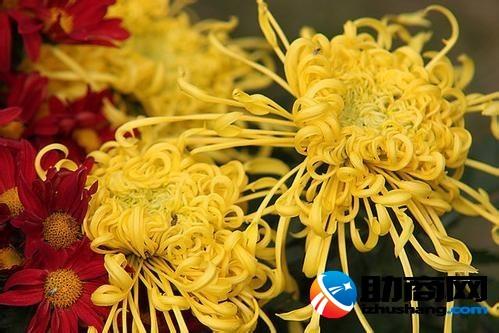
Potted chrysanthemum (potted chrysanthemum)
Single chrysanthemum (variety chrysanthemum, specimen chrysanthemum): cultivated with a large chrysanthemum, each pot, with a flower, a single plant alone. Can fully reflect the characteristics of the variety, in addition to ornamental, can be used for variety identification, so it is also known as variety chrysanthemum or specimen chrysanthemum.
Multiple chrysanthemums (multi-headed chrysanthemum, multi-headed variety of chrysanthemum): cultivated with large flowers, each pot has more than one plant, with several to dozens of flowers. For display and viewing of gardens, meeting venues, etc.
Desk chrysanthemum: plant big chrysanthemum in a small basin, one plant for each pot, one flower for each plant, skirt leaves to cover the basin, small flowers for large, high and uncovered feet, suitable for placing on several desks, and can be arranged in halls, bedrooms and studies.
Tile tube chrysanthemum: chrysanthemum seedlings are planted in tile Jane. After budding, remove the tile tube and move it into the basin for viewing.
Potted chrysanthemum: plant the chrysanthemum seedlings on the ground first, wait for the chrysanthemum plant to grow to a certain size, put it into the earthen pot from the pot hole, and cut off the pot bottom root for viewing after showing color.
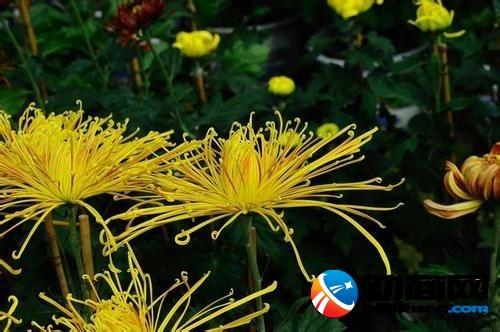
Use of chrysanthemum:
[chrysanthemum wine]: made from chrysanthemum plus glutinous rice and koji, it is called "longevity wine" in ancient times. it tastes cool and sweet and has the functions of nourishing liver, eyesight, brain, anti-aging and so on.
[chrysanthemum porridge]: make porridge with chrysanthemum and japonica rice, which is refreshing, pleasing to the eye and dryness.
[chrysanthemum tea]: making tea with chrysanthemum flowers has a fragrant smell, which can relieve summer heat, invigorate fluid, dispel wind, moisten the throat, nourish eyes and relieve alcohol.
[chrysanthemum cake]: mix chrysanthemums in rice milk and steam them into cakes, or make cakes with mung bean powder and chrysanthemums, which has a cool and fire-free dietotherapy effect.
[chrysanthemum cuisine]: "chrysanthemum meat slices" fried with chrysanthemum and pork or snake meat or cooked with fish and chicken are vegetarian, tonic but not greasy, refreshing and refreshing, and can be used for the treatment of dizziness and wind-heat disturbance.
[chrysanthemum soup]: boil or steam chrysanthemum with Tremella or lotus seeds and add a little rock sugar to relieve irritation, benefit the five internal organs, chrysanthemum pictures (20) to treat dizziness and other diseases.
[chrysanthemum ointment]: fresh chrysanthemum is boiled with water, filtered and concentrated, mixed with refined honey, and made into ointment, which has the effect of soothing wind and clearing heat and eyesight.
[chrysanthemum pillow]: dry the chrysanthemum petals and put them into the pillow, which has a good effect on hypertension, dizziness, insomnia and red eyes.
[chrysanthemum knee pads]: mash chrysanthemum and Chen Aiye into coarse powder and put them into gauze bags to make knee pads, which can dispel wind and dehumidification, reduce swelling and pain, and treat arthritis such as crane knee wind.
[chrysanthemum aroma]: it has the function of soothing wind and calming the liver, smelling it, and has an auxiliary therapeutic effect on colds and headaches.
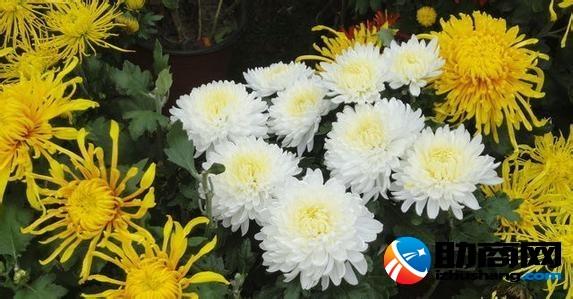
Symbolic significance of Chrysanthemum Literature
1. Symbolize where the Tao of Heaven lies.
Zhonghui, the son of the painter Zhong Kui in the three Kingdoms, once wrote "Chrysanthemum Fu", believing that chrysanthemums are inspired by the spirit of heaven and earth, which makes people feel where the Tao of heaven lies. Therefore, the chrysanthemum is a symbol of the way of heaven.
two。 It symbolizes integrity and unyielding.
Chrysanthemum, also known as "yellow flower", was regarded as the yellow earth in the ancient Chinese nation, so yellow is also medium color and positive color. The chrysanthemum blossoms in the frost, proud and unyielding, symbolizing the integrity and unyielding of the Chinese nation.
3. Symbolize auspiciousness and longevity
Chrysanthemum is known as the "longevity guest" with the effect of "nourishing nature and applying medicine, which can be light and prolong life". People match chrysanthemum with other flowers, images and words with the same rhyme to form a variety of rich "auspicious language" patterns to embellish life and achieve happiness and longevity.
4. Symbolize elegance and purity
Qu Yuan's "Lisao" has "the fall of autumn chrysanthemum in western food". Bai Juyi "Yong Ju" has "cold resistance only East Lei Chrysanthemum, Golden millet at dawn more clear." They all use chrysanthemums as a metaphor for people of noble character, who are not in cahoots with the world, and are a symbol of elegance and purity.
5. The leisurely symbol of seclusion
Tao Yuanming "drinking" picked wild flowers by the fence and accidentally saw Nanshan. " It depicts the seclusion of the hermit in the countryside, which is often used by later generations, so the chrysanthemum also symbolizes the serenity and comfort of the hermit's seclusion.
6. Symbolize the fighter.
The yellow nest has "rustling west wind planted all over the yard, Rui cold fragrance cold butterfly difficult to come." If I were the Green Emperor in his year, I would bloom with the peach blossoms. "when autumn comes to September 8, I will kill a hundred flowers after blooming. The incense in the sky penetrates Chang'an, and the city is full of gold armour. " In his poems with obvious moral and tendency, Chrysanthemum has become a brave and strong fighter who has experienced many vicissitudes, pleading for the people and doing justice for heaven. In the meantime, Don? Cen Shen's "March for nine days to think of the hometown of Chang'an"strong desire to climb high, no one to send wine, pity the hometown chrysanthemum, should be close to the battlefield." Chrysanthemum also became the representative of warriors.
7. A symbol of sadness
Li Qingzhao "drunken Huayin has Dongli wine after dusk, there are dark fragrance sleeves." Mo Tao does not disappear, the curtain rolls the west wind, and the person is thinner than the yellow flower. " Li Qingzhao, a female poet in the Song Dynasty, Chrysanthemum, became the object of expressing feelings in her writings. Use the word "thin" to express your sadness to your long-lost husband.
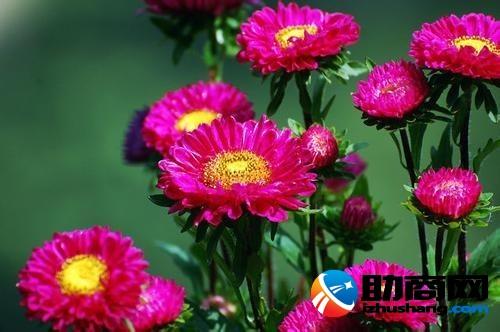
Pest control
Spot blight is also known as leaf blight. It started in the middle and late ten days of April, causing damage to leaves. Control methods: after the flowers were harvested, all the plants on the ground were cut off and burned; at the initial stage of the disease, the diseased leaves were removed and alternately sprayed with 1 ∶ 1 ∶ lbo Bordeaux solution and 50% Trozin 1000 times solution.
Fusarium wilt occurred from early June to early July, and the disease was serious after flowering, causing damage to the whole plant and rotting roots. Control methods: select disease-free old roots to keep seeds; rotation; make high beds, open deep ditches, reduce humidity; pull out diseased plants, and sprinkle lime powder on diseased holes or irrigate them with 50% carbendazim 1000 times solution.
Insect pests: chrysanthemums are planted all the year round, providing adequate nourishment and habitat for pests and harmful mites. Therefore, chrysanthemum can not escape the harm of pests or pests whether it is cultivated in the net room or in the open air. The important pests on chrysanthemum are aphids, thrips, Spodoptera litura, Spodoptera exigua, Spodoptera litura and Spodoptera litura. The secondary pests are root cutter, inchworm, Liriomyza huidobrensis, whitefly, poisonous moth, powdery beetle, silkworm, etc., and there are quite a number of species. Chrysanthemums (cut flowers or potted flowers) for domestic sale can allow a small number of pests as long as they do not affect the quality of the flowers. .
Weeds: chrysanthemum cultivation mostly belongs to open field cultivation and rotation with paddy fields. Common dry field weeds in water and dry rotation fields occur in chrysanthemum fields. The competition harm of weeds is related to the cultivation mode, grass phase, density, competition period and environmental factors of chrysanthemum. The competition of weeds for water, nutrients and light can directly lead to the poor growth and quality of chrysanthemum. It is not conducive to field management and so on.
The above introduction is how to cultivate potted chrysanthemum, chrysanthemum use, symbolic significance and pest control, hope to help you.

- Prev
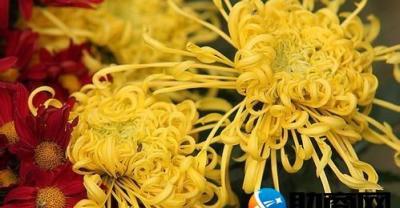
Do aquaculture, you must master this data!
According to the data of animal husbandry in Henan Province in 2017, the GDP of Henan Province in 2017 was 4.498816 trillion yuan, an increase of 7.8% over the previous year, and the growth rate was 0% higher than the national average.
- Next
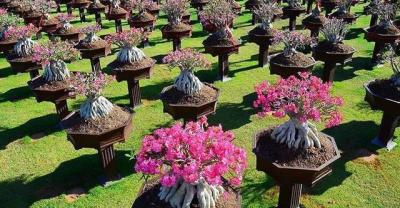
Is bamboo rat breeding a way to get rich or a pit of fraud?
For the current popular bamboo rat breeding, some accept and start breeding, some wait and see, and some have been deceived and said to be fraudulent. Without mentioning anything else for the time being, let's start with history.
Related
- On the eggshell is a badge full of pride. British Poultry Egg Market and Consumer observation
- British study: 72% of Britons are willing to buy native eggs raised by insects
- Guidelines for friendly egg production revised the increase of space in chicken sheds can not be forced to change feathers and lay eggs.
- Risk of delay in customs clearance Australia suspends lobster exports to China
- Pig semen-the Vector of virus Transmission (4)
- Pig semen-the Vector of virus Transmission (3)
- Five common causes of difficult control of classical swine fever in clinic and their countermeasures
- Foot-and-mouth disease is the most effective way to prevent it!
- PED is the number one killer of piglets and has to be guarded against in autumn and winter.
- What is "yellow fat pig"? Have you ever heard the pig collector talk about "yellow fat pig"?

